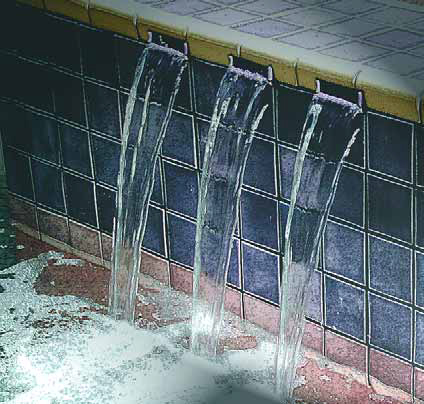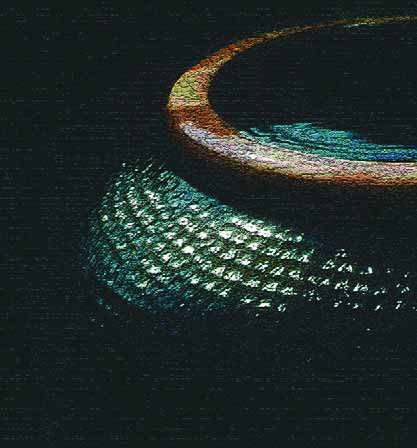construction
As much I enjoy seeing my own projects come to fruition, there's something wonderful in seeing watershapers I know achieve great results in their work. I admire and encourage the effort, especially when the outstanding outcomes are the result of a professional's concentrated efforts to improve his or her own skills. This is one of the reasons I teach: I take great satisfaction in sharing my techniques, sensibilities and the conviction that what I do is special, a true form of art.Sometimes I speak with former
I'm steadily reminded of one key point: No matter how talented any one of us might be, the work ultimately is not about us. For intensely creative people equipped with the necessary measures of self-confidence and ego, that point can be tough to accept and absorb, but it's true: For all our skills, we nonetheless work with our clients' visions, and the reality is that creating sympathetic designs for them takes time, patience and lots of effort. As a result, I'm passionate about uncovering what my clients are truly after in their garden and watershape designs. It's an investment of time and energy at the onset of the relationship that always
At a time when scores of American cities are still looking for ways to revive the faded glory of their urban cores, possible approaches are as visionary (and numerous) as can be. The process has resulted in new parks, major redevelopment, architectural restorations and a long list of other solutions - including the unique watershape commissioned by the city of White Plains, N.Y. A town with 54,000 full-time residents whose population swells to more than 200,000 during the day when office workers, shoppers and visitors come calling, White Plains made the decision to invest $4.5 million of public and private grant money in resurrecting a small downtown park. Appropriately named Renaissance Plaza, the park surrounds a state-of-the-art musical fountain unveiled in October 2003 for the specific purpose of luring people back to the downtown area - and it has worked. In fact, the plaza has become such a hub of activity that nearly 1,700 units of new residential housing are now under construction in its downtown neighborhood. URBAN OBJECTIVE First settled by British colonists who bought it from the Mohican tribe in 1683, this historically rich city located 25 miles north of Manhattan has truly been reborn, and it's with no small measure of
It may have been in the heart of the depression, but 1932 was a good year for American swimmers: The Olympic Games in Los Angeles saw Clarence "Buster" Crabbe win gold in the 400-meter freestyle in the then-world-record time of 4:48.2 and Helene Madison win gold medals in both the 100- and 400-meter freestyle events. U.S. swimmers claimed nine medals in all, in many cases besting swimmers from the powerful and heavily favored Japanese team. The competition was held in an eight lane, 50-meter pool positioned quite literally in the shadow of the Los Angeles Memorial Coliseum. Just as the names and records of those swimmers have faded across 70-plus years, so too had the swimming pool and its companion recreation pool. Although they had remained in near-continuous use for generations, the old vessels were supplanted when a modern swimming pool complex opened on the nearby campus of the University of Southern California in anticipation of the 1984 Los Angeles Olympiad. Early in 2003, we at Rowley International of Palos Verdes Estates, Calif., were asked to renovate the old facility's two swimming pools. The City of Los Angeles, along with support from the Amateur Athletic Federation (AAF), set a goal that didn't involve
Next to the water itself, concrete is the most important and widespread of materials used in watershaping. Not only is it instrumental in creating the structures that contain water as well as the substructures that support them, concrete is also the stuff of which faux-rock panels, pre-cast or poured-in-place coping, pavers, all manner of stamped or textured decks and poured-in-place or block walls are made. Despite its omnipresence, however, concrete remains one of the most misunderstood of all watershaping materials in this sense: Because it is so durable in basic structural applications, there's a tendency to
Composition of this article began with an e-mail I received a while ago from a colleague working in Australia. "What," he asked, "is the maximum allowable depth for a fountain in the United States?" As simple as it sounded, when I took the time to research the issue I found that there was a noticeable lack of definition. I took the next logical step and called various people I know in the watershaping industry and asked them the same question. Surprisingly enough, nobody could point me to any code, regulation or standard that defined what depth a waterfeature's pool could
A tremendous amount of synergy and teamwork went into the making of "The Ultimate Family Home." Initiated by Builder magazine (the official publication of the National Association of Home Builders) and Pardee Homes (the Los Angeles-based developer of the Nevada Trails neighborhood in which the home was built), the project unfolded as a partnership between the magazine and the developer's Las Vegas office along with Bassenian-Lagoni Architects (Newport Beach, Calif.), Color Design Art (Los Angeles) and Lifescapes International (the Newport Beach-based landscape-architecture firm). "The Ultimate Family Home" opened in January 2004 in conjunction with
It's unusual to think of such a wonderfully decorative watershape in this way, but the one featured in this edition of "Details" was the result of a client's desire for a measure of safety for the front of his home. The house is located on an intersection in a hilly part of Manhattan Beach, Calif., where the steep, downhill orientation of the streets occasionally lead cars to make turns at unwisely high speeds. Given the orientation of his front door, my client was concerned that, with a bit of very bad luck, he might someday find an out-of-control-driver's car in his foyer. As is the case with many






















